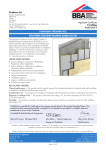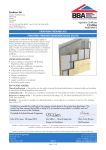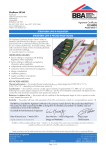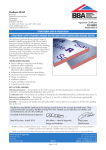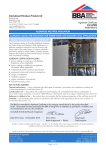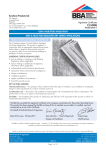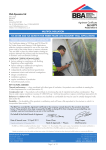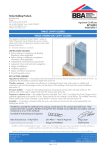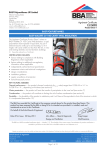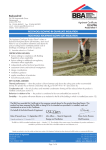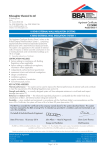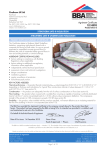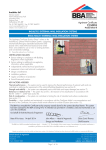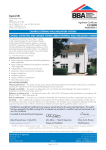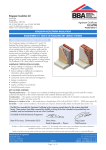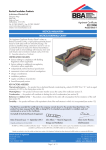Download Warm-R (Pitched Roof) BBA Cert PDF
Transcript
Hytherm (Ireland) Ltd APPROVAL INSPECTION TESTING CERTIFICATION Liscarton Industrial Estate Kells Road Navan Co Meath Ireland Tel: 00 353 46 9066000 Fax: 00 353 46 9066090 TECHNICAL APPROVALS FOR CONSTRUCTION Agrément Certificate 97/3417 e-mail: [email protected] website: www.hytherm.com Product Sheet 1 HYTHERM WARM-R INSULATION WARM-R HYLOC PITCHED ROOF INSULATION This Agrément Certificate Product Sheet (1) relates to Warm-R Hyloc Pitched Roof Insulation, comprising slotted or tongue-and-groove expanded polystyrene boards, for use between and over timber pitched roofs of new and existing domestic and non-domestic buildings. (1) Hereinafter referred to as ‘Certificate’. CERTIFICATION INCLUDES: • factors relating to compliance with Building Regulations where applicable • factors relating to additional non-regulatory information where applicable • independently verified technical specification • assessment criteria and technical investigations • design considerations • installation guidance • regular surveillance of production • formal three-yearly review. KEY FACTORS ASSESSED Thermal performance — the EPS 70 and EPS 100 products have a thermal conductivity (D value) of 0.038 W·m–1·K–1 and 0.035 W·m–1·K–1 respectively (see section 6). Condensation — the risk of interstitial condensation should be assessed for each project (see section 7). Behaviour in relation to fire — the products will not contribute to the development stages of a fire (see section 8). Durability — the products will have a life equivalent to that of the roof structure in which they are incorporated (see section 13). The BBA has awarded this Certificate to the company named above for the products described herein. These products have been assessed by the BBA as being fit for their intended use provided they are installed, used and maintained as set out in this Certificate. On behalf of the British Board of Agrément Date of First issue: 17 September 2014 John Albon — Head of Approvals Claire Curtis-Thomas Originally certificated on 29 October 1997 Energy and Ventilation Chief Executive The BBA is a UKAS accredited certification body — Number 113. The schedule of the current scope of accreditation for product certification is available in pdf format via the UKAS link on the BBA website at www.bbacerts.co.uk Readers are advised to check the validity and latest issue number of this Agrément Certificate by either referring to the BBA website or contacting the BBA direct. British Board of Agrément Bucknalls Lane Watford Herts WD25 9BA ©2014 Page 1 of 9 tel: 01923 665300 fax: 01923 665301 e-mail: [email protected] website: www.bbacerts.co.uk Regulations In the opinion of the BBA, Warm-R Hyloc Pitched Roof Insulation, if installed, used and maintained in accordance with this Certificate, will satisfy or contribute to satisfying the relevant requirements of the following Building Regulations (the presence of a UK map indicates that the subject is related to the Building Regulations in the region or regions of the UK depicted): The Building Regulations 2010 (England and Wales) (as amended) Requirement: C2(c) Resistance to moisture Comment: The risk of interstitial condensation must be assessed for each construction. The products can adequately limit the risk of surface condensation. See sections 7.1 and 7.4 of this Certificate. Requirement: L1(a)(i) Conservation of fuel and power Comment: Regulation: 7 The products can contribute to satisfying this Requirement. See section 6 of this Certificate. Comment: Regulation: 26 Regulation: 26A Regulation: 26A Regulation: 26B The products are acceptable. See section 13 and the Installation part of this Certificate. Comment: The products can contribute to satisfying these Regulations, but compensating fabric measures may be required. See section 6.2 of this Certificate. Materials and workmanship CO2 emission rates for new buildings Fabric energy efficiency rates for new dwellings (applicable to England only) Primary energy consumption rates for new buildings (applicable to Wales only) Fabric performance values for new dwellings (applicable to Wales only) The Building (Scotland) Regulations 2004 (as amended) Regulation: 8(1) Durability, workmanship and fitness of materials Comment: The products can satisfy the requirements of this Regulation. See section 13 and the Installation part of this Certificate. Regulation: Standard: Building standards applicable to construction Condensation 9 3.15 Comment: The risk of interstitial condensation must be assessed for each construction. The products can adequately limit the risk of surface condensation, with reference to clauses 3.15.1(1)(2), 3.15.3(1)(2), 3.15.4(1)(2), 3.15.5(1)(2) and 3.15.7(1)(2). See sections 7.1 and 7.5 of this Certificate. Standard: Standard: Carbon dioxide emissions Building insulation envelope 6.1(b) 6.2 Comment: The products can contribute to satisfying clauses, or parts of clauses, 6.1.2(2), 6.1.6(1), 6.2.1(1)(2), 6.2.3(1), 6.2.4(2), 6.2.5(2), 6.2.6(1), 6.2.7(1), 6.2.8(2) 6.2.9(1)(2), 6.2.10(1), 6.2.11(1)(2), 6.2.12(2) and 6.2.13(1)(2) of these Standards. See section 6 of this Certificate. Standard: Statement of sustainability 7.1(a)(b) Comment: Regulation: 12 The products can contribute to satisfying the relevant requirements of Regulation 9, Standards 1 to 6, and, therefore will contribute to a construction meeting a bronze level of sustainability as defined in this Standard. See section 6.2 of this Certificate. Building standards applicable to conversions Comment: Comments made in relation to these products under Regulation 9, Standards 1 to 6, also apply to this Regulation, with reference to clause 0.12.1(1)(2) and Schedule 6(1)(2). (1) Technical Handbook (Domestic). (2) Technical Handbook (Non-Domestic). The Building Regulations (Northern Ireland) 2012 Regulation: 23 Fitness of materials and workmanship Comment: Regulation: 29 The products are acceptable. See section 13 and the Installation part of this Certificate. Comment: The risk of interstitial condensation must be assessed for each construction. See section 7.1 of this Certificate. Regulation: Regulation: Conservation measures Target carbon dioxide emission rate 39(a)(i) 40(2) Comment: Condensation The products can contribute to satisfying these Regulations. See section 6 of this Certificate. Construction (Design and Management) Regulations 2007 Construction (Design and Management) Regulations (Northern Ireland) 2007 Information in this Certificate may assist the client, CDM co-ordinator, designer and contractors to address their obligations under these Regulations. See sections: 3 Delivery and site handling (3.3) and 14 General (14.2) of this Certificate. Page 2 of 9 Additional Information NHBC Standards 2014 NHBC accepts the use of Warm-R Hyloc Pitched Roof Insulation, when installed and used in accordance with this Certificate, in relation to NHBC Standards, Chapter 7.2 Pitched roofs. CE marking The Certificate holder has taken the responsibility of CE marking the products in accordance with harmonised European Standard BS EN 13163 : 2012. An asterisk (*) appearing in this Certificate indicates that data shown is given in the manufacturer’s Declaration of Performance. Technical Specification 1 Description 1.1 Warm-R Hyloc Pitched Roof Insulation, is a two-layer expanded polystyrene board system consisting of Hyloc Panels (EPS 70 slotted boards) and Plus Panels (EPS 100 tongue-and-groove boards). 1.2 Hyloc Panels (layer one) are designed to insulate between the rafters. A width variation feature (being slotted) is used to provide width adjustment if required, to ensure a permanent tight fit (see Figure 1). Plus Panel (layer two) provides an interlocking layer over rafters. Figure 1 Hyloc Panels width adjustment feature 1.3 The boards have the nominal characteristics as shown in Table 1. Table 1 Nominal characteristics Hyloc Panels (EPS 70) Plus Panels (EPS 100) Length (mm) 1200 1200 Width (mm) to suit designed rafter centres 600 75 to 130 (in 5 mm increments) 40, 50, 60 Thickness* (mm) Thermal conductivity* (D) values (W·m–1·K–1) 0.038 0.035 Edge profile Square Tongue-and-groove 1.4 Ancillary items for use with this products but outside the scope of this Certificate are: • water vapour permeable roof tile underlay • InSkew type fixings or other similar spiral fixings • galvanized slab nails or ring-shank nails • timber battens • vapour control layer (VCL) and plasterboard. 2 Manufacture 2.1 Raw beads are expanded with steam to the required density. An automated process cures and cuts the products to the required size. 2.2 As part of the assessment and ongoing surveillance of product quality, the BBA: • agreed with the manufacturer the quality control procedures and product testing to be undertaken • assessed and agreed the quality control operated over batches of incoming materials • monitored the production process and verified that it is in accordance with the documented process • evaluated the process for management of nonconformities • checked that equipment has been properly tested and calibrated • undertaken to carry out the above measures on a regular basis through a surveillance process, to verify that the specifications and quality control operated by the manufacturer are being maintained. Page 3 of 9 2.3 The management system of Hytherm (Ireland) Ltd has been assessed and registered as meeting the requirements of BS EN ISO 9001 : 2008 by Loss Prevention Certification Board (Certificate 851). 3 Delivery and site handling 3.1 The products are delivered to site in polythene shrink-wrapped packs containing a label bearing the manufacturer’s trade name, product description, and the BBA identification mark incorporating the number of this Certificate. 3.2 It is essential that the products are stored such that they are raised off the ground, are inside or under cover on a flat, dry, level surface in a well-ventilated area. The products must be protected from rain, snow and prolonged exposure to sunlight. Boards that have been allowed to get wet or that are damaged must not be used. Nothing should be stored on top of boards. 3.3 The products must not be exposed to a naked flame or other ignition sources nor to solvents or other chemicals. Assessment and Technical Investigations The following is a summary of the assessment and technical investigations carried out on Warm-R Hyloc Pitched Roof Insulation. Design Considerations 4 General 4.1 Warm-R Hyloc Pitched Roof Insulation is for use as thermal insulation in new and existing pitched roofs of dwellings or other buildings with similar temperature and humidity conditions, in conjunction with a vapour-permeable roof tile underlay. The systems are installed above sloping rafters (Plus Panels) and between sloping rafters (Hyloc Panels). For improved thermal/carbon-emissions performance, the designer should consider additional/alternative fabric and/or services measures. 4.2 Roofs should be designed and constructed in accordance with the relevant clauses of BS 5534 : 2003, BS 5250 : 2011, BS 8212 : 1995 and BS EN 1995-1-1 : 2004 and its UK National Annex. 4.3 Although the products will contribute to the buckling and racking strength of the roof, normal cross-bracing must be incorporated to achieve buckling and racking strength requirements. 4.4 During installation, care should be exercised to ensure that the products are not subjected to any construction, or foot traffic loads. Roof timbers of adequate strength should be used to support such loads. 4.5 It is essential that detailing and jointing of the boards achieves a convection-free envelope (see also section 7.3). Any gaps should be filled, and/or taped. Ridges, abutments and penetrations should also be sealed. Flue pipes passing through the insulation should be suitably sleeved. 4.6 Proper care and attention must be given to maintaining the integrity/continuity of the VCL. 4.7 The requirements/provisions of fire stops should be considered with regard to national Building Regulations. 5 Practicability of installation The products are designed to be installed by a competent general builder, or a contractor, experienced with these types of products. 6 Thermal performance 6.1 Calculations of the thermal transmittance (U value) should be carried out in accordance with BS EN ISO 6946 : 2007 and BRE Report BR 443 : 2006 using the thermal conductivity* (D) values of 0.038 W·m–1·K–1 and 0.035 W·m–1·K–1 for the Hyloc Panels (EPS 70) and Plus Panels (EPS 100) respectively. 6.2 The U value of a completed roof will depend on the thickness of insulation used, the number and type of fixings and the insulating value of other roof components/layers. Example U values of roofs incorporating the products are shown in Table 2 of this Certificate. Table 2 U values (1) Element type Sloping roof with LR underlay Timber dimensions (mm) 47 x 150 at 600 centres Insulation thickness(2) (mm) and location with respect to rafters between outside 105 130 40 60 (3) (3) (3) (3) (3) (3) (3) (3) (1) Plasterboard taken as 12.5 mm at 0.25 W·m ·K . (2) Nearest available thickness. (3) See section 4.1. –1 –1 Page 4 of 9 U value (W·m–2·K–1) 0.25 0.20 0.18 0.16 0.15 0.13 6.3 The products can contribute to maintaining continuity of thermal insulation at junctions between elements. For Accredited Construction Details the corresponding -values (psi) in BRE Information Paper IP 1/06, Table 3 may be used in carbon emission calculations in Scotland and Northern Ireland. Detailed guidance for other junctions and on limiting heat loss by air infiltration can be found in: England and Wales — Approved Documents to Part L and for new thermal elements to existing buildings, Accredited Construction Details (version 1.0). See also SAP 2009 The Government’s Standard Assessment Procedure for Energy Rating of Dwellings, Appendix K and the iSBEM User Manual for new-build Scotland — Accredited Construction Details (Scotland) Northern Ireland — Accredited Construction Details (version 1.0). 7 Condensation Interstitial condensation 7.1 Roofs will adequately limit the risk of interstitial condensation when they are designed and constructed in accordance with BS 5250 : 2011, Annex D and Annex H and BRE Report BR 262 : 2002 for roofs in England and Wales. 7.2 For the purposes of assessing the risk of interstitial condensation, the product’s water vapour resistivity value may be taken from Table 3, which corresponds to the least favourable water vapour resistivity value. Table 3 Water vapour resistivity Product grade Water vapour resistivity (MN·s·g–1·m–1) Hyloc Panels 100 to 200 Plus Panels 150 to 350 7.3 To minimise moisture entering the roof an effective VCL such as 125 μm minimum thickness polyethylene with sealed and lapped joints, should be placed between the insulation and the internal finish. Surface condensation 7.4 Roofs will adequately limit the risk of surface condensation when the thermal transmittance (U value) does not exceed 0.35 W·m–2·K–1 at any point and the junctions are designed in accordance with Limiting thermal bridging and air leakage : Robust construction details for dwellings and similar buildings TSO 2002, BRE Information Paper IP 1/06 or section 6.3 of this Certificate. 7.5 Roofs will adequately limit the risk of surface condensation when the thermal transmittance (U value) does not exceed 1.2 W·m–2·K–1 at any point. Guidance may be obtained from BS 5250 : 2011, Annex H, or section 6.3 of this Certificate. Additional information can be found in BRE Report BR 262 : 2002. 8 Behaviour in relation to fire 8.1 The products are not classified as ‘non combustible’. 8.2 When installed with an internal lining board securely fixed to timber, eg 12.5 mm thick plasterboard, the product will be contained between the element and internal lining board until one is destroyed. Therefore, the products will not contribute to the development stages of a fire until the lining is compromised. 8.3 The use of the products will not affect the fire rating obtained by tiled or slated roofs when evaluated by assessment or test to BS 476-3 : 2004. 8.4 Elements must incorporate cavity barriers at edges, around openings and at junctions with fire-resisting elements, and the maximum dimensions of any cavity in any direction must not exceed 10 metres in accordance with the relevant provisions of the national Building Regulations. The design and installation of cavity barriers must take into account any anticipated differential movement. 9 Strength The products, when installed in accordance with the manufacturer’s instructions and this Certificate, will resist the loads likely to be met during installation and in service. 10 Structural stability (over rafter application only) 10.1 Resistance to wind uplift will depend largely on the building geometry and its geographical location and should be calculated in accordance with BS EN 1991-1-4 : 2005. Snow loadings should be calculated in accordance with BS EN 1991-1-3 : 2003. 10.2 When calculating the fixing spacing required to resist the calculated loadings, the requirements of BS EN 1995-1-1 : 2004 should be followed where possible. Further guidance can be obtained from the Certificate holder. The Certificate holder must advise on the use of the correct proprietary fixings and approved nails and fixing capacity in accordance with BS EN 1995-1-1 : 2004. Page 5 of 9 11 Resistance to moisture An effective roof tile underlay will protect the products from wind-driven snow or rain penetrating the tiles/slates in service. 12 Maintenance As the products are placed within the roof and have suitable durability (see section 13), maintenance is not required. 13 Durability The products will have a life equivalent to that of the roof structure in which they are incorporated. Installation 14 General 14.1 Installation of Warm-R Hyloc Pitched Roof Insulation must be in accordance with the relevant clauses of BS 5534 : 2003, the manufacturer’s instructions and can be carried out in all conditions normal to roofing work. 14.2 The boards are light to handle but some handling difficulties may be experienced in windy conditions. Since the products will not support the weight of operatives, appropriate care must be taken during installation and tiling. 14.3 The products can be cut easily using a sharp knife or fine tooth saw but care must be taken to prevent damage, particularly to edges. Damaged boards should not be used. 14.4 A tight fit must be ensured between the products and rafters, the products at the ridge and at roof/wall junctions. 14.5 It is important to fill/seal gaps and joints in the insulation envelope (see section 4.5). 14.6 Where the products are installed in traditional timber-frame construction, cavity barriers at the junction of the external wall and roof space should be provided. 14.7 Roof tiles or slates are installed in accordance with the relevant clauses of BS 5534 : 2003. 14.8 When applying roof tiles or slates to a warm roof construction, the recommendations of the manufacturer must be followed. 14.9 The products should be installed in conjunction with an appropriate internal lining board for example standard gypsum plasterboard to BS EN 520 : 2004 in accordance with BS 8212 : 1995. 15 Procedure 15.1 The first run of Hyloc Panels are fitted between rafters keeping panels flush with the top face of the rafter and closely butted at ends, commencing at the eaves (see Figure 2). Figure 2 Two-layer pitched roof system 15.2 The first run of Plus Panels is laid over the rafters running across the roof and held in position by a counter batten (44 mm by 35 mm) lightly tacked in place along the line of the rafters. 15.3 Remaining runs of Plus Panels are positioned with the tongue-and-groove fully engaged and vertical joints staggered. Page 6 of 9 15.4 The procedure is repeated using crawling boards until both layers reach ridge level. The counter batten must be nailed firmly in place (see Figure 3). Figure 3 Typical fixing method 15.5 vapour-permeable roof tile underlay is positioned over the counter battens, in accordance with the manufacturer’s instructions. A continuous timber fillet to support the underlay below the lowest row of tiles is recommended (see Figure 4). Figure 4 Overhanging eaves detail 15.6 Any gaps must be sealed with flexible sealant or expanding foam. 15.7 Where required, a sealed polythene VCL with a minimum thickness 125 μm with lapped and sealed joints is installed before applying the internal finish. Technical Investigations 16 Investigations 16.1 An examination was made of test data to BS EN 13163 : 2012 relating to: • density • water vapour resistance • dimensional accuracy • dimensional stability • thermal conductivity • dimensions • squareness • flatness • density • compressive strength at 10% compression. Page 7 of 9 16.2 An assessment was made of typical constructions which achieve the design U values. 16.3 The manufacturing process was examined, including the methods adopted for quality control, and details were obtained of the quality and composition of the materials used. Bibliography BS 476-3 : 2004 Fire tests on building materials and structures — Classification and method of test for external fire exposure to roofs BS 8212 : 1995 Code of practice for Dry lining and partitioning using gypsum plasterboard BS 5250 : 2011 Code of practice for control of condensation in buildings BS 5534 : 2003 Code of practice for slating and tiling (including shingles) BS EN 520 : 2004 Gypsum plasterboards — Definitions, requirements and test methods BS EN 1991-1-3 : 2003 Eurocode 1 : Actions on structures — General actions — Snow loads BS EN 1991-1-4 : 2005 Eurocode 1 : Actions on structures — General actions — Wind actions BS EN 1995-1-1 : 2004 Eurocode 5 : Design of timber structures — General — Common rules and rules for buildings NA to BS EN 1995-1-1 : 2004 UK National Annex to Eurocode 5 : Design of timber structures — General — Common rules and rules for buildings BS EN 13163 : 2012 Thermal insulation products for buildings — Factory made expanded polystyrene (EPS) products — Specification BS EN ISO 6946 : 2007 Building components and building elements — Thermal resistance and thermal transmittance — Calculation method BS EN ISO 9001 : 2008 Quality management systems. Requirements BRE Information Paper IP 1/06 Assessing the effects of thermal bridging at junctions and around openings BRE Report (BR 262 : 2002) Thermal insulation: avoiding risks BRE Report (BR 443 : 2006) Building components and building elements — Thermal resistance and thermal transmittance — Calculation method Page 8 of 9 Conditions of Certification 17 Conditions 17.1 This Certificate: • relates only to the product/system that is named and described on the front page • is issued only to the company, firm, organisation or person named on the front page — no other company, firm, organisation or person may hold or claim that this Certificate has been issued to them • is valid only within the UK • has to be read, considered and used as a whole document — it may be misleading and will be incomplete to be selective • is copyright of the BBA • is subject to English Law. 17.2 Publications, documents, specifications, legislation, regulations, standards and the like referenced in this Certificate are those that were current and/or deemed relevant by the BBA at the date of issue or reissue of this Certificate. 17.3 This Certificate will remain valid for an unlimited period provided that the product/system and its manufacture and/or fabrication, including all related and relevant parts and processes thereof: • are maintained at or above the levels which have been assessed and found to be satisfactory by the BBA • continue to be checked as and when deemed appropriate by the BBA under arrangements that it will determine • are reviewed by the BBA as and when it considers appropriate. 17.4 The BBA has used due skill, care and diligence in preparing this Certificate, but no warranty is provided. 17.5 In issuing this Certificate, the BBA is not responsible and is excluded from any liability to any company, firm, organisation or person, for any matters arising directly or indirectly from: • the presence or absence of any patent, intellectual property or similar rights subsisting in the product/system or any other product/system • the right of the Certificate holder to manufacture, supply, install, maintain or market the product/system • actual installations of the product/system, including their nature, design, methods, performance, workmanship and maintenance • any works and constructions in which the product/system is installed, including their nature, design, methods, performance, workmanship and maintenance • any loss or damage, including personal injury, howsoever caused by the product/system, including its manufacture, supply, installation, use, maintenance and removal • any claims by the manufacturer relating to CE marking. 17.6 Any information relating to the manufacture, supply, installation, use, maintenance and removal of this product/ system which is contained or referred to in this Certificate is the minimum required to be met when the product/system is manufactured, supplied, installed, used, maintained and removed. It does not purport in any way to restate the requirements of the Health and Safety at Work etc. Act 1974, or of any other statutory, common law or other duty which may exist at the date of issue or reissue of this Certificate; nor is conformity with such information to be taken as satisfying the requirements of the 1974 Act or of any statutory, common law or other duty of care. British Board of Agrément Bucknalls Lane Watford Herts WD25 9BA ©2014 Page 9 of 9 tel: 01923 665300 fax: 01923 665301 e-mail: [email protected] website: www.bbacerts.co.uk









